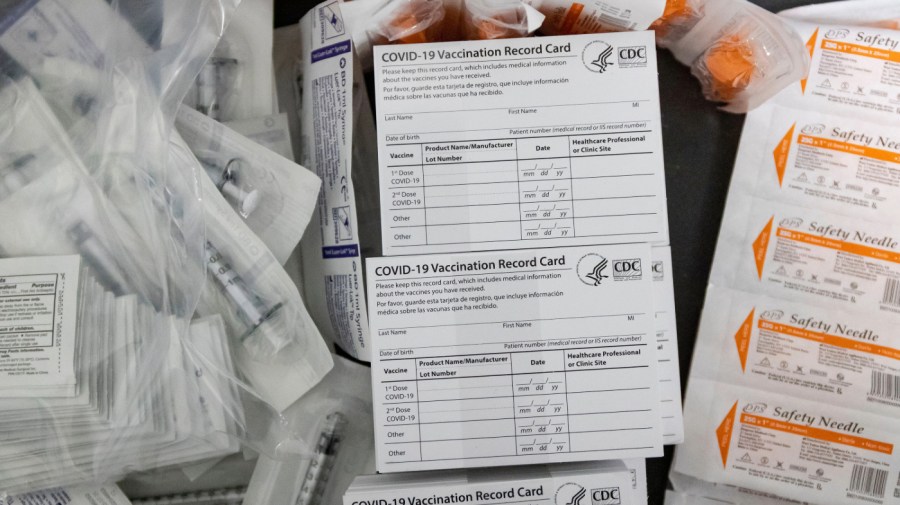Stricter COVID-19 restrictions could have saved hundreds of thousands of lives in the states that refused to institute them, though efforts to close nursing homes and schools likely caused more harm than good, a new study has found.
Between 118,000 and 248,000 more Americans would have survived the pandemic if all states had followed some restrictions practiced in Northeastern states, according to findings published on Friday in the Journal of the American Medical Association (JAMA).
The most effective responses were mask mandates and vaccine requirements rest, the JAMA study found.
“COVID-19 restrictions saved lives,” the researchers wrote.
“The death toll was probably considerably higher than it would otherwise have been in states that resisted imposing these restrictions, banned their use, or implemented them for only relatively short periods of time.”
Vaccine requirements and mask mandates have been politically controversial, and continue to cast a shadow on politicians in Washington.
Bu the JAMA research extolled these policies, and said they should help guide public health response in future pandemics even as an uncontrolled rise in bird flu hits the West.
At first, there was little difference in COVID-19 response between red and blue states, the researchers noted.
For the first four months of the pandemic, most states pursued overlapping and nearly-universal strategies like closing businesses and schools and imposing mask mandates.
About 57 percent of Texans supported the mask restrictions, according to polling from The University of Texas. Those numbers are roughly in line with the 62 percent nationwide who told pollsters at Pew that the lives saved were worth what nearly 70 percent acknowledged as a considerable economic costs.
But by the middle of 2020, as right-leaning groups fomented opposition to these restrictions, conservative governments in states like Texas reacted by banning mask mandates.
As late as 2023, Texas Governor Greg Abbott (R) was telling conservative talk show hosts that he would keep his pandemic-derived emergency powers in place until state legislators “codify my executive orders that ban mask mandates, that ban forced vaccines and things like that,” the Texas Tribune reported.
The cost of these reactions in conservative states was tens or hundreds of thousands of additional deaths — a cost that would have been even worse if all states had followed their lead, the JAMA researchers found.
If all states had followed more lenient practices in the Southeast or Texas, as many as 200,000 people would have died, the study found.
At its most dramatic, Mississippi — the state with the weakest restrictions — saw five times as many deaths per-capita as Massachusetts, a state with among the strongest restrictions, the study found.
The findings emphasized that all interventions weren’t equally helpful, and that particularly when it came to closures of public spaces, the costs may have outweighed benefits. As much as three-fourths of the lives saved by restrictions could be attributed to just two — masks and vaccines.
By contrast, the researchers found, benefits were weakest for school closures, which hurt students’ social development and test scores without achieving much benefit in reducing the death rate.
For high-poverty school districts, this disparity was particularly stark. A study by the National Bureau of Economic Research found that low-income districts that went remote in the 2020 – 2021 school year, for example, “will need to spend nearly all of their federal aid on academic recovery to help students recover from pandemic-related achievement losses.
The data suggests that school closures “may have been too aggressively pursued in some states,” the researchers found.
On the other hand, requiring students and teachers to wear masks was “probably more effective and imposed lower costs.”
Another area where researchers argued that the costs of restrictions likely outweighed benefits was social isolation for nursing home residents — which seem to have saved people from death by COVID-19 but caused them to be more likely to die overall.
The researchers acknowledged that simply saving lives was “not necessarily sufficient to justify imposing restrictions because they also imposed a variety of costs,” though they noted that some of these — like “loss of liberty” — were difficult to quantify.
But by using accepted actuarial numbers for the monetary value of a life — from about $5 million to about $12 million — they found that the lives that could have been saved by stronger restrictions was on the order of $1.2 to $5.2 trillion.
That’s the equivalent of between 6 and 22 percent of 2021-era GDP.
